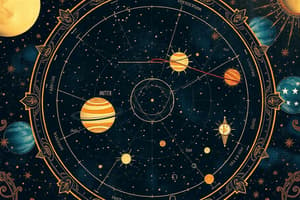Podcast
Questions and Answers
Which of the following defines an astronomical unit?
Which of the following defines an astronomical unit?
- The distance between any two stars
- The average distance from the Earth to the Sun (correct)
- The total size of the solar system
- The distance light travels in one year
The Earth experiences seasons due to its distance from the Sun.
The Earth experiences seasons due to its distance from the Sun.
False (B)
What are the 8 different phases of the moon?
What are the 8 different phases of the moon?
New Moon, Waxing Crescent, First Quarter, Waxing Gibbous, Full Moon, Waning Gibbous, Last Quarter, Waning Crescent
The Sun's primary source of energy is through _____ reactions.
The Sun's primary source of energy is through _____ reactions.
Match the celestial objects to their descriptions:
Match the celestial objects to their descriptions:
What is the primary factor that causes seasons on Earth?
What is the primary factor that causes seasons on Earth?
The inner planets of the solar system are primarily gas giants.
The inner planets of the solar system are primarily gas giants.
What are the two types of magnitude that describe how bright a star appears?
What are the two types of magnitude that describe how bright a star appears?
The Sun's primary energy source comes from _____ reactions.
The Sun's primary energy source comes from _____ reactions.
Match each celestial object with its correct characteristic:
Match each celestial object with its correct characteristic:
Which astronomical phenomenon involves the alignment of the Earth, Moon, and Sun?
Which astronomical phenomenon involves the alignment of the Earth, Moon, and Sun?
All stars go through the same life cycle regardless of their size.
All stars go through the same life cycle regardless of their size.
What is the role of a spectroscope in astronomy?
What is the role of a spectroscope in astronomy?
During a lunar eclipse, the Earth casts a shadow on the _____
During a lunar eclipse, the Earth casts a shadow on the _____
Match the following moon phases with their characteristics:
Match the following moon phases with their characteristics:
Flashcards
Astronomical Unit
Astronomical Unit
The average distance between the Earth and the Sun, approximately 150 million kilometers.
Celestial Objects
Celestial Objects
Objects that exist in space, such as planets, stars, and moons.
Lunar Eclipse
Lunar Eclipse
When the Earth blocks sunlight from reaching the Moon.
Solar Eclipse
Solar Eclipse
Signup and view all the flashcards
Star's Life Cycle
Star's Life Cycle
Signup and view all the flashcards
Astronomical Unit (AU)
Astronomical Unit (AU)
Signup and view all the flashcards
Scientific Notation
Scientific Notation
Signup and view all the flashcards
Inner Planets
Inner Planets
Signup and view all the flashcards
Outer Planets
Outer Planets
Signup and view all the flashcards
Why does the Sun appear to rise and set?
Why does the Sun appear to rise and set?
Signup and view all the flashcards
Why do we have seasons on Earth?
Why do we have seasons on Earth?
Signup and view all the flashcards
What is a spectroscope?
What is a spectroscope?
Signup and view all the flashcards
Sun's Energy Source
Sun's Energy Source
Signup and view all the flashcards
Apparent Magnitude
Apparent Magnitude
Signup and view all the flashcards
HR Diagram
HR Diagram
Signup and view all the flashcards
Study Notes
LG1: Describing the Solar System and Universe
- Define astronomical units
- Convert between standard and scientific notation
- Identify major components of the solar system and universe
LG2: Comparing and Contrasting Celestial Objects
- Identify inner and outer planets
- Categorize celestial objects based on properties
- Analyze relative sizes and distances of planets
LG3: Understanding Astronomical Phenomena
- Explain lunar and solar eclipses based on relative positions of the Sun, Earth, and Moon
- Describe Earth-Moon-Sun relationships and relative sizes
- Explain the rising and setting of the Sun
- Describe Earth's seasons
- Illustrate and identify the 8 phases of the Moon
- Relate Moon phases to the relative positions of the Earth, Moon, and Sun
LG4: Sun's Composition and Energy
- Describe the Sun's composition and energy source
- Explain the Sun's warming effect on Earth and life support
- Identify parts of the Sun and their significance
- Compare the Sun to other stars in terms of size
LG5: Stellar Life Cycles
- Explain apparent vs. absolute magnitude of stars
- Correlate star color with temperature
- Describe the use of spectroscopes to identify stellar composition
- Outline different stages of stellar evolution (based on star size)
- Interpret Hertzsprung-Russell (HR) diagrams
Studying That Suits You
Use AI to generate personalized quizzes and flashcards to suit your learning preferences.




